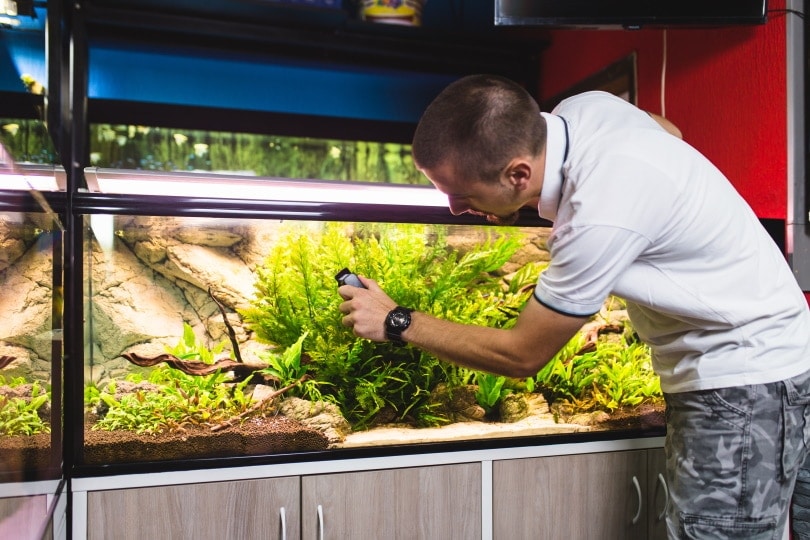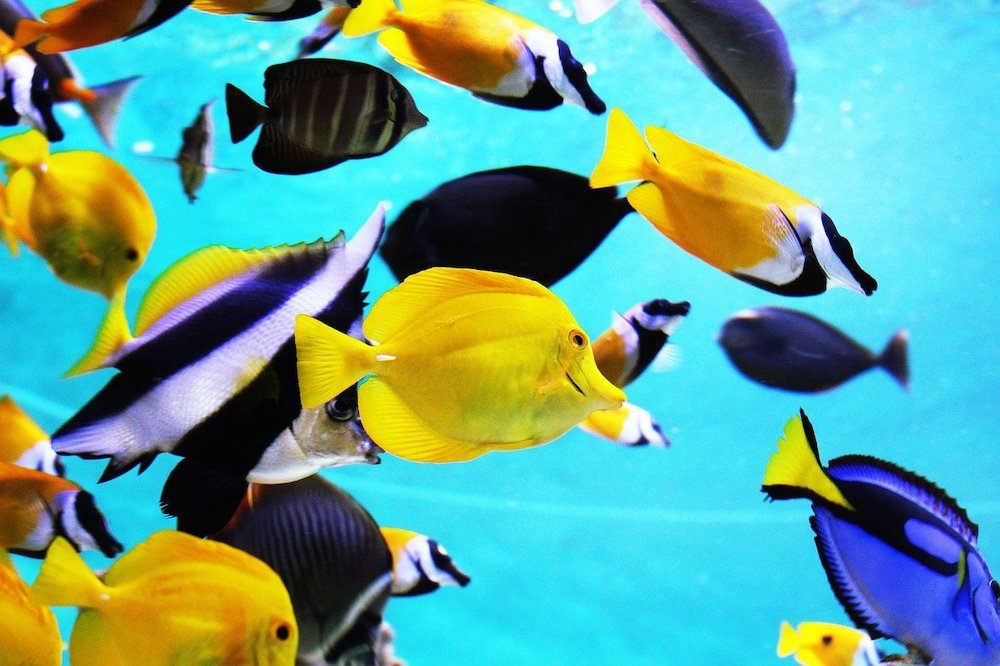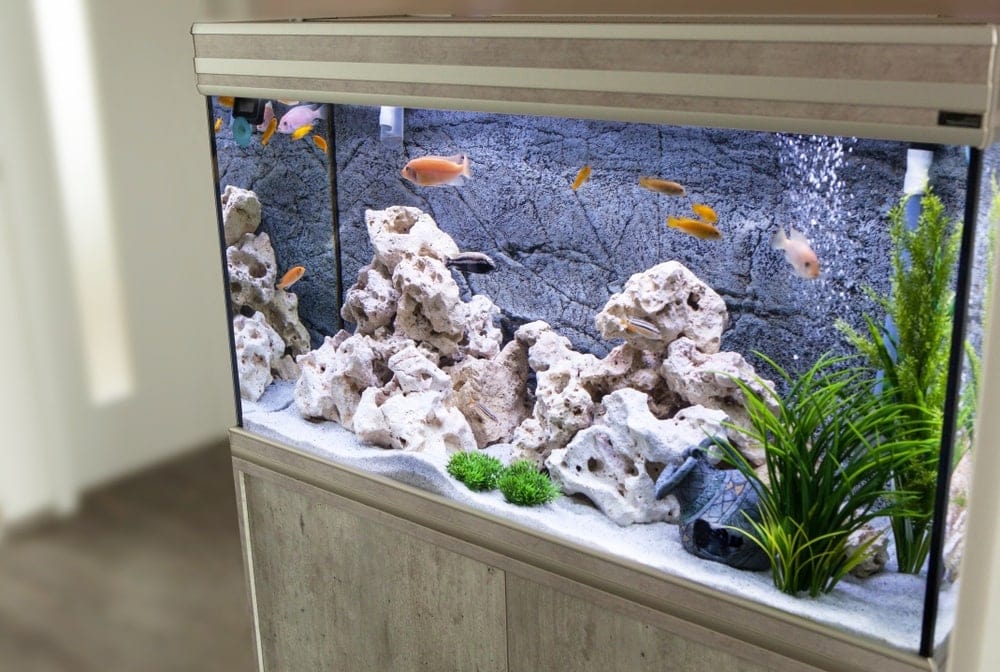Jack Dempsey Fish: Care Guide, Types, Lifespan, Pictures & More

Updated on
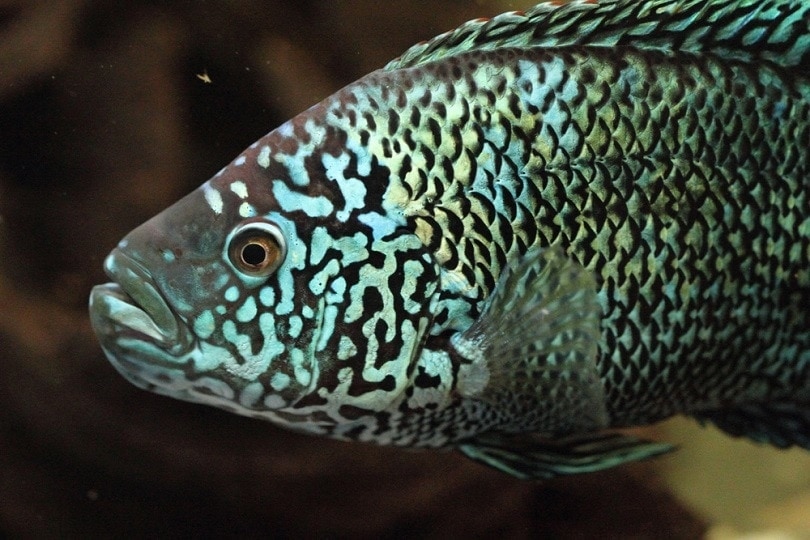
Jack Dempsey (Rocio octofasciata) is a carnivorous species of fish with an active and aggressive nature. They are a type of cichlid fish originating from freshwater rivers in Belize, Guatemala, Mexico, and Honduras. Jack Dempsey’s are fascinating and ethereal-looking fish. They have a unique body coloration that consists of golden or silver flecks. They are incredibly attractive under fluorescent lights and are best appreciated for their size and beauty in large tropical tanks.
Although Jack Dempsey’s are not friendly towards other vulnerable fish, they have a unique personality that enables them to form strong bonds with their owners. This appealing fish will make an excellent addition to a predator tank. This guide will inform you of the best possible way to care for your Jack Dempsey fish. As well as give you tips on how to keep them in successful community tanks and provide the best home possible for them.
Quick Facts about Jack Dempsey’s
| Species Name: | Rocio octofasciata |
| Family: | Cichlids |
| Care Level: | Intermediate |
| Temperature: | 75°F to 82°F |
| Temperament: | Aggressive |
| Color Form: | Grey with bright patterns |
| Lifespan: | 8 to 15 years |
| Size: | 12 to 15 inches |
| Diet: | Carnivore |
| Minimum Tank Size: | 180 gallons per fish, 300 gallons for a small community tank |
| Tank Set-Up: | Freshwater: tropical, sparsely decorated, large, high filtration and aeration |
| Compatibility: | Poor, consumes many varieties of fish |
Jack Dempsey Overview
Jack Dempsey fish are respected and praised amongst the predator fish community. They are well sought after as one of the best predatory cichlids for aquarists. Although they make a desirable pet fish, they are one of the most misunderstood fish in the hobby.
Pet stores sell these fish at a noticeably young age and when they are still under 4 inches. This attracts an adoring new aquarist looking for a new addition to their tank, only to be surprised when their new fish grows to a whopping 15 inches in under a year. This leads to many cases of aquarists giving up the hobby completely when they cannot meet the overwhelming demands of this large carnivorous fish. This is because a full grow Jack Dempsey requires an extremely large tank that is expensive to upkeep.
Aside from them falling into the wrong hands, they are also known to eat nearly all their tankmates regardless of the species or size. This makes them hard to keep in community tanks when owners place them with incompatible species. Understanding the overall nature and requirements of this fish will allow you to get the best out of their beauty and spunky personalities.
In the right home, these fish will quickly flourish into beautiful beasts that enhance many large tanks. Their bodies reflect common house lights which will capture the attention of their shiny scales. When your Jack Dempsey fish is provided a large and suitable home that it can comfortably turn around in, they will reward you with dog-like characteristics that will instantly capture your heart. They have been known to follow their owners through along glass and appreciate snack time by boasting their hearty appetite.
Maintaining your Jack Dempsey’s tank and diet will allow them to live their long lifespan of 15 years old. The more space and care your fish receive, the longer it will live. This makes it important to ensure you meet all its needs and ensure that you provide them with the correct tank conditions.
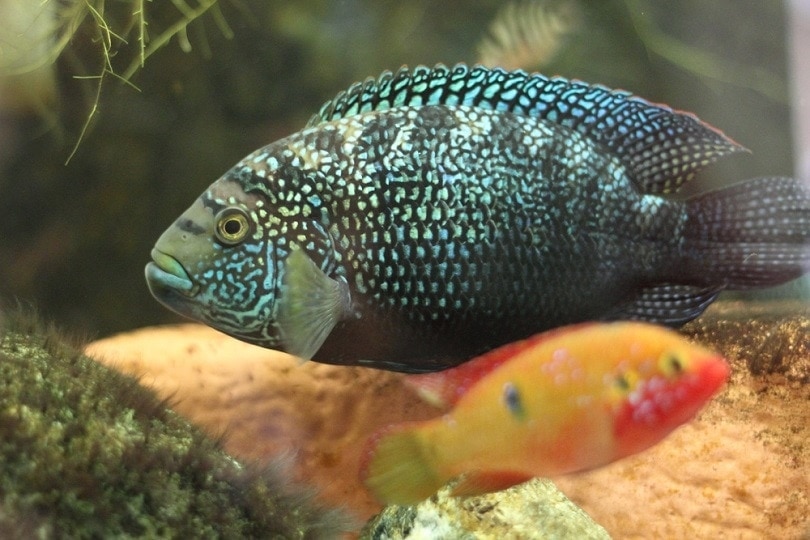
How Much Do Jack Dempsey’s Cost?
Jack Dempsey’s are commonly available from pet stores or online breeders. You can expect to pay approximately $3 to $5 for one. A typical pet store Jack Dempsey fish will be $3 but a local fish store selling high-quality adults may charge $5 for one. The same applies to online sites that will charge a fee of $4, and the transportation fees are added to the additional price. You should expect to not pay more than $10 for a Jack Dempsey fish.
Although they are not a common fish that many pet stores will readily stock, the bigger carnivorous tanks will most likely have several of these fish. Also, do a health check before purchasing them. This will ensure that you are taking home a fish from healthy stock.
Typical Behavior & Temperament
If you are not used to caring for a predatory species of fish that is aggressive, you might be put off on owning one of these fish. This makes Jack Dempsey fish better suited for intermediates who have some experience with aquatic fish keeping. Jack Dempsey’s are quite aggressive and will attack and eat other fish in a poorly populated tank. They do better in large community tanks with other predatory fish. Males tend to be territorial and will defend their territory from other fish in the tank.
If you keep a low amount of tankmates, you can expect your Jack Dempsey to single out a tank mate and harass them. This behavior can be curbed by introducing several predatory fish into the tank. These are middle or bottom-dwelling fish who can also appear shy and take shelter in large hideouts throughout the tank.
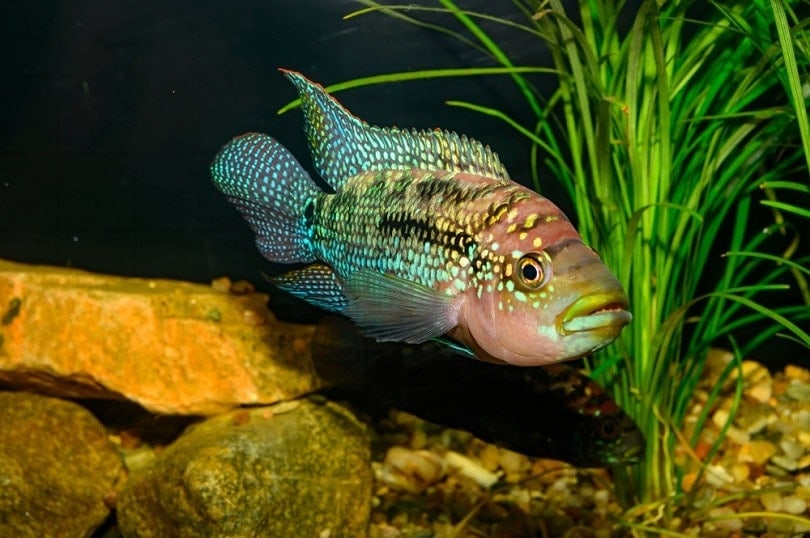
Appearance & Varieties
This attractive species of fish has long fins with an oval body. The males will have longer finned and be slightly larger than female Jack Dempsey fish. Their name originates from their similar features arising from the Boxer in the 1920s, Jack Dempsey. They have a set of unique colors and are seen in various shades of golds, pinks, and blues. The color is not as pronounced as seen in other fish, but with the right lighting, you can genuinely appreciate their colors.
All these fish are decorated with gold to green flecks. These flecks can take on the form of various shapes. They typically change color as they age and gradually become brighter as they get older. You will find juveniles to be a pale gray color and older Jack Dempsey’s to have a pinker undertone to their grey coloration. Also, keep in mind that their color can be altered with their mood. Stressed Jack Dempsey fish will develop a pale body, whereas courting males may look darker. It is easy to determine the gender of your Jack Dempsey by looking at their finnage. Males will have a long dorsal fin and an anal fin with pointed tips. Females have rounded shorter fins that are less pronounced than their male counterparts.
Pet stores will commonly sell a less aggressive type of Jack Dempsey with bright blue coloring. They will generally grow smaller and have a tamer personality.
How to Take Care of Jack Dempsey Fish
Habitat, Tank Conditions & Setup
Tank/aquarium size
These fish grow too large lengths in captivity. This makes them suited to tanks in the 200-gallon range. Although you may get your Jack Dempsey when they are still below 6 inches, they can grow between 12 to 15 inches. Keeping them in a small tank will only increase their aggressive behavior and cause them to get stressed. The tank needs to be large enough to support its full size if you do not plan to upgrade the tank along as they grow.
A newly purchased juvenile Jack Dempsey can live in a tank as small as 80 gallons until it reaches 6 inches in length. If you plan to keep a community tank with your Jack Dempsey, you will have to ensure the tank is a minimum of 300 gallons to support the bio load and size of all the fish.
Water temperature and pH
Jack Dempsey’s do well in a range of water temperatures and are considered as temperate water fish. This means they can thrive in both cold and tropical water conditions. It is best to meet their ideal requirements in the middle and ensure the water is not too cold or overly warm. They can tolerate a heater in their tank. A good temperature range for these fish is between 75°F to 82°F. Keep in mind they range from tropical climates and should not have temperatures that go below 72°F. We recommend keeping these fish at 78°F. They require acidic water with a pH level of 6 to 7.
Substrate
They naturally occur from muddy waters and appreciate a sandy substrate. Large pebbles and gravel can be used with these fish, but only if aquarium sand is not available.
Plants
Tall growing live plants with minimal leaves do best with Jack Dempsey fish. You want to provide sparsely decorated tanks so that they have enough space to swim. Rocky caves and driftwood are also a good idea when you are decorating the tank. Large terracotta pots provide a shelter for your fish to hide inside. Plants also provide them with a hiding place which is valuable for shy fish. Mature hornwort, amazon swords, and Anubis make great plants for them.
Lighting
Moderate lighting is recommended for these fish. They originate from dark water and tannins help replicate this environment in captivity,
Filtration
Since they are so large, a good quality filter should be used for effective waste management. Jack Dempsey’s are also messy feeders, and their water should regularly be changed so that the fouling food does not cause a sudden ammonia spike.

Are Jack Dempsey’s Good Tank Mates?
Due to their aggressive nature, they make poor tank mates. They are better suited to being kept in predatory community tanks with other aggressive fish like cichlids. Since these fish will eat anything that can fit into their mouth, all the tank mates should be at least half the size of them.
It is crucial to avoid fish that have long-flowing fins as your Jack Dempsey will rip and attack them. Their temperament requires careful planning when it comes to finding an ideal tank mate for them. Community tanks buffer the amount of individual harassment they can inflict on one fish at a time and keep the fish in the tank stress-free.
Your Jack Dempsey will generally establish its territory and ward off other fish. When they feel stressed, they will kill other tank mates, but this is most common when their tank is too small. Jack Dempsey’s can tolerate living with each other if the tank is large enough.
- Cichlids
- Oscars
- Kissing Gourami
- Green terror fish
- Angelfish
- Bettas
- Goldfish
- Mollies
- Aquarium snails
- Shark varieties
- Schooling tetras
- Danios
- Guppies
What to Feed Your Jack Dempsey
These fish are primarily carnivores and consume a meat-based diet. They thoroughly enjoy a variety of live foods rich in protein. They are not fussy when it comes to feeding time and will happily eat what you can provide. This makes it essential to ensure that you are providing them with the best diet possible. In the wild, they eat worms, crustaceans, larvae, and even small fish. This should be replicated in captivity to ensure that they are kept healthy.
A good commercial diet will ensure that they consume enough protein to grow and maintain their energy levels. A high-quality pellet is a good staple for these fish. The pellet should be large and specifically formulated for predatory fish. Alongside a good commercial pellet, foods like live brine shrimp, bloodworms, tubifex cubes, and smaller feeder fish can be fed. Avoid feeder fish like goldfish as they have low nutritional value and commonly come with parasites.
Keeping Your Jack Dempsey Healthy
Keeping them healthy is achievable if their needs are met. A large tank, a good diet, and suitable tank mates will ensure your Jack Dempsey is thriving. If your fish is on a low-quality diet, they will not be able to develop properly and have a shortened lifespan as a result. This is also true if their tank requirements are not met.
Your Jack Dempsey should have at least two hiding spaces to feel comfortable. Avoiding stress will keep your fish in good health. Ensure that the tank is large enough for adequate swimming space. The temperature and pH requirements of the water should be replicated from their wild conditions and a powerful filter should be always running to keep the tank clean.
Conduct regular water tests to determine the amount of ammonia, nitrite, and nitrates in the water. This will also give you a good indication of when to do a water change.
Breeding
Jack Dempsey’s will only successfully mate if their breeding conditions are almost an exact replicate to their wild conditions. This means that the water temperature should be raised to 80°F and the water must be kept pristine. A gradual succession of water changes over a period should be done to encourage breeding. A slow temperature increase by several degrees should be implemented. These conditions will trigger their breeding response and a female will seek out a male.
Keep in mind that the larger the male is, the more likely the female is to be attracted to him. In return, this higher the likelihood of this pair to mate. A breeding tank should be set up to carry on the process from which the breeding pair should be removed from. This prevents the parents from eating any eggs or fry that hatch. When Jack Dempsey fish are ready to mate, their color will noticeably darken. It is also important to keep an eye on them when mating season occurs. Males will become more aggressive and potentially kill females if they are not ready to mate.
Are Jack Dempsey’s Suitable for Your Aquarium?
These fascinating fish can make great additions to the right tank. The environment should be up to their standards and efforts are taken to provide as much swim space as possible. Tanks that have sparse vegetation and large hiding places can work well for these fish. Careful research and size comparisons should be done between the Jack Dempsey and the current tanks inhabitants before they are introduced.
If you can meet all of these fishes needs and provide a stable home for them, the Jack Dempsey fish may be right for you. We hope this guide has helped you understand this fish a lot better!
Featured Image Credit: Photofenik, Shutterstock




